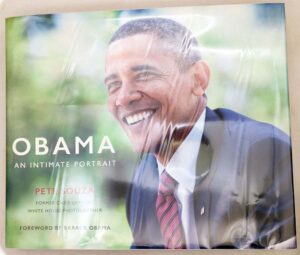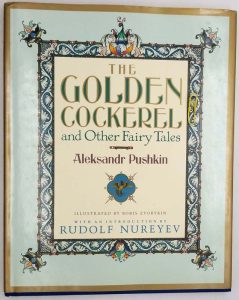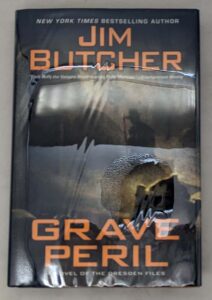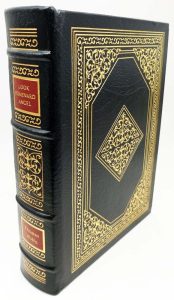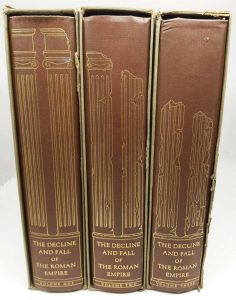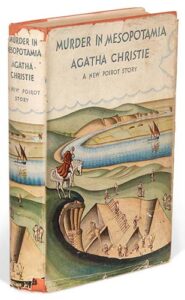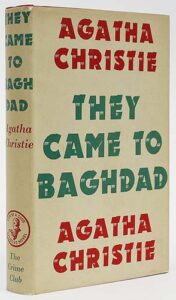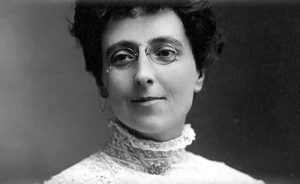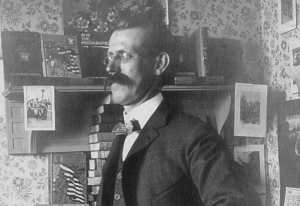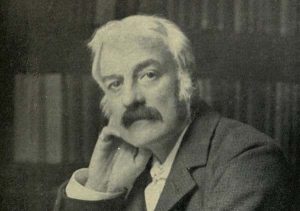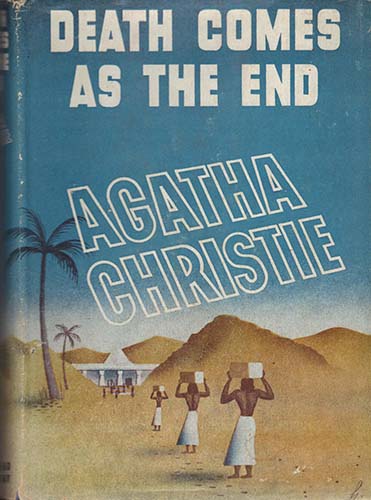
Death Comes as the End is a historical mystery novel by Agatha Christie, first published in the US by Dodd, Mead and Company in October 1944 and in the UK by the Collins Crime Club in March of the following year. The US Edition retailed at $2.00 and the UK edition at seven shillings and sixpence (7/6).
It is the only one of Christie’s novels not to be set in the 20th century, and – unusually for her – also features no European characters. Instead, the novel is set in Thebes in 2000 BC, a setting for which Christie gained an appreciation whilst working with her archaeologist husband, Sir Max Mallowan, in the Middle East. The novel is notable for its very high number of deaths and is comparable to And Then There Were None from this standpoint. It is also the first full-length novel combining historical fiction and the whodunit/detective story, a genre which would later come to be called the historical whodunit.
The suggestion to base the story in ancient Egypt came from noted Egyptologist and family friend Stephen Glanville. He also assisted Christie with details of daily household life in Egypt 4000 years ago. In addition he made forceful suggestions to Christie to change the ending of the book. This she did but regretted the fact afterwards, feeling that her (unpublished) ending was better. The novel is based on real letters translated by egyptologist Battiscombe Gunn, from the Egyptian Middle Kingdom period, written by a man called Heqanakhte to his family, complaining about their behaviour and treatment of his concubine.
It is one of only four Christie novels to have not received an adaptation of any kind, the others being Destination Unknown, Passenger to Frankfurt and Postern of Fate.
Christie uses a theme for her chapter titles, as she did for many of her novels, in this case the Egyptian agricultural calendar.
Plot Summary
[SPOILER ALERT]
The quiet lives of an Egyptian family are disturbed when the father, Imhotep, returns from the north with his new concubine, Nofret, who begins to sow discontent amongst them. Once the deaths begin, fears are aroused of a curse upon the house, but is the killer closer to home?
The novel is primarily written from the perspective of Renisenb, a young widow reacquainting herself with her family when her father Imhotep, a successful but pompous and short-sighted mortuary priest, brings a new “wife”, Nofret, into their lives. Nofret soon disrupts and antagonises Imhotep’s sons – Yahmose, Sobek and Ipy – as well as their wives. Renisenb realises the housekeeper Henet, while feigning devotion, is full of hatred. She confronts Henet near the end of the story, who in a fit of pique admits she hates Renisenb and hated Renisenb’s long-deceased mother.
After Imhotep is called away, Satipy and Kait, the elder sons’ wives, try to bully Nofret with tricks, but the plan backfires when Nofret appeals to Imhotep and he threatens to disown his sons and their families upon his return. Suddenly everyone has a motive to kill Nofret and when she is found dead at the foot of a cliff, an accident seems unlikely, although no one will acknowledge anything else.
Next, Satipy falls to her death in terror from the same cliff while walking with Yahmose. Renisenb, and others, wonder if it was Nofret’s vengeful spirit that she was looking at over Yahmose’s shoulder moments before her death. This theory gathers force when Yahmose and Sobek drink poisoned wine. Sobek dies, but Yahmose lingers on, having drunk less of the wine. A slave boy who says he saw Nofret’s ghost poisoning the wine dies of poison shortly afterwards.
The handsome scribe Kameni has fallen in love with Renisenb, and eventually asks her to marry him. Unsure whether she loves him or her father’s advisor Hori, whom she has known since she was a child, she leaves the choice effectively in her father’s hands and becomes engaged to Kameni. She realises, however, that his relationship with Nofret was closer than she had supposed, and that jealousy may have influenced Nofret’s bitter hatred towards the family. Hori and Esa, the elderly mother of Imhotep (a clever woman who although almost completely blind sees things clearer than most others – especially her son) begin to investigate the possibility of a human murderer. Ipy, himself a likely suspect, starts to boast about his new, better position with his father; he plots to get rid of housekeeper Henet and tells her so. The next morning, Ipy is found dead in the lake, drowned.
The field of suspects has been further narrowed. Esa attempts to flush out the murderer by dropping a hint about the death of Satipy, but is herself murdered by means of poisoned unguent, despite the presence of a food taster. Henet – who knows the murderer’s identity and is momentarily powerful amid the chaos – is smothered by the linens used to wrap the ever-increasing number of victims.
On the same cliff path where Nofret and Satipy died, Renisenb, apparently summoned by Hori, hears footsteps behind her and turns to see Yahmose. She then sees the look of murderous hatred in her brother’s eyes that Satipy saw before she was killed. As Renisenb is about to be killed, however, Hori slays Yahmose with an arrow and saves her. Hori explains to Renisenb that Satipy was not looking in fear at anything beyond Yahmose — she was looking straight at him. He had consumed a non-lethal dose of poison and pretended to recuperate while committing murders, both to make himself chief heir and to indulge his newfound love of violence. Renisenb’s final choice is whom to marry: Kameni, a lively husband not unlike her first, or Hori, an older and more enigmatic figure. She makes her choice and falls into Hori’s arms.
Publication history
- 1944, US, Dodd & Mead, October 1944, hardback (First US edition), 223 pp
- 1945, UK, The Crime Club Collins, March 1945, hardback (First UK edition), 160 pp
- 1947, Pocket Books (New York), Paperback, (Pocket number 465), 179 pp
- 1953, Penguin Books, Paperback, (Penguin number 926), 188 pp
- 1960, Fontana Books (Imprint of HarperCollins), Paperback, 191 pp
- 1957, Pan Books, Paperback, 221 pp
Death Comes as the End – First Edition Book Identification Guide
The books are listed in the order of publication. While the majority of Agatha Christie’s books were first published in the UK. There are many titles that were first published in the US. The title of the book may differs from the UK edition in some cases.
| Year | Title | Publisher | First edition/printing identification points |
|---|---|---|---|
| 1945 | Death Comes as the End | Dodd, Mead & Co, NY, 1945 | First edition. Date on the title & copyright page matches. No statement of later printings. Blue cloth lettered in black. Price $2.00. |
| 1945 | Death Comes as the End | William Collins & Sons, London, [1945] | First English edition. "1945" on single line stated on the copyright page. No statement of later printings. Red cloth lettered in black. Price 7/6. |
Note about Book Club Editions (BCE) and reprints:
UK: You can see statements of later reprint dates or of book club on the copyright page.
US: The US reprint publishers usually use the same sheets as the first edition and are harder to identify by looking at the title page or the copyright page. One may identify a BCE by looking at the DJ, which doesn’t have a price on top of the front flap and a “Book Club Edition” imprint at the bottom. If the dust jacked is clipped at both the top/bottom of the front flap. You can safely assume it’s a BCE . If the book is missing the dust jacket. Later BCE editions can be identified by its plain boards, while first printings are issued in quarter cloth.
Please refer to the gallery for detailed images of true first edition bindings and dust jackets.
Death Comes as the End – First Edition Dust Jacket Identification Guide
First edition bindings and various dust jacket printings identification.
